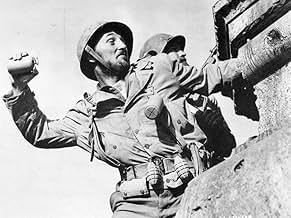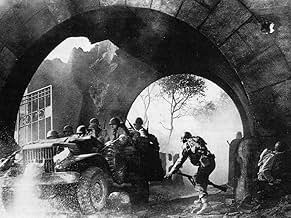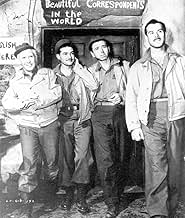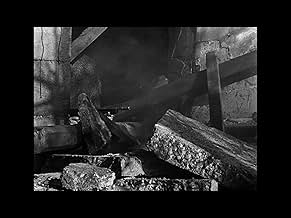At the close of WWII, Pulitzer Prize-winning war correspondent Ernie Pyle travels with the U.S. Army's Company C Division during their liberation of Italy.At the close of WWII, Pulitzer Prize-winning war correspondent Ernie Pyle travels with the U.S. Army's Company C Division during their liberation of Italy.At the close of WWII, Pulitzer Prize-winning war correspondent Ernie Pyle travels with the U.S. Army's Company C Division during their liberation of Italy.
- Nominated for 4 Oscars
- 5 wins & 8 nominations total
John R. Reilly
- Private Murphy
- (as Jack Reilly)
William Murphy
- Private Mew
- (as Bill Murphy)
William 'Billy' Benedict
- Pvt. Whitey
- (uncredited)
Michael Browne
- Sergeant
- (uncredited)
Bob Hope
- Bob Hope (Voice on Radio Program)
- (voice)
- (uncredited)
Kenneth Kendall
- Extra
- (uncredited)
Yolanda Lacca
- Amelia, Italian Girl
- (uncredited)
Barney Noto
- Staff Sergeant Barney Noto
- (uncredited)
Tito Renaldo
- Lopez
- (uncredited)
Dick Rich
- Sergeant at Showers
- (uncredited)
William Self
- Pvt. Cookie Henderson
- (uncredited)
Storyline
Did you know
- TriviaThe extras in the film were real American GIs, in the process of being transferred from the war in Europe to the Pacific. Many of them were killed in the fighting on Okinawa--the same battle in which Ernie Pyle was killed by a Japanese machine gunner--never having seen the movie in which they appeared.
- GoofsThe unit Pyle is with--the 18th Infantry Regiment, 1st Infantry Division--never fought in the Italian campaign. After the Sicilian campaign ended, it was brought back to England and began training for the D-Day invasion in Normandy. The 1st Division would eventually spearhead the assault on Omaha Beach.
- Quotes
Pvt. Dondaro: If this War don't kill me first, my feet will.
- Crazy creditsThere are absolutely no credits at the end of the film, not even the words "The End".
- ConnectionsEdited from San Pietro (1945)
- SoundtracksSilent Night
(uncredited)
Music by Franz Xaver Gruber
Lyrics by Joseph Mohr
Sung by Elfie Mayerhofer on Decca Record
Featured review
After searching for the best war films all my life, and after seeing so much tripe, I was completely flabbergasted by this film, of which I had heard, but had never seen until last night. Most films made during the Second World War were pure propaganda, all dash and glory, but with little resemblance to real battle. "The Story of G.I. Joe" is the real McCoy, especially considering that it was made near the end of the war. You can feel, taste and smell the muck and fear these men lived with. The dialogue is gritty, the combat scenes, especially of urban fighting bang on. One exceptional and rare scene was of an anti-tank gun crew swinging into action and firing 12 rounds a minute in a town. It was a battle ballet and an example of the lethality of a well-trained and seasoned team. In my opinion, this film ranks with Steven Spielberg's "Saving Private Ryan" as the best film of infantry in combat ever made. In fact, I believe that Spielberg may even have made 'Ryan' as an homage to Wellman's great earlier film; many of the scenes and much of the dialogue is very similar. In 1945, General Eisenhower called 'G.I. Joe' the greatest war film ever made. I'm sure he would say the same thing today. This should be a must-see for every student studying this country's fighting history and every American in uniform should see it.
- How long is Story of G.I. Joe?Powered by Alexa
Details
- Release date
- Country of origin
- Languages
- Also known as
- Ernie Pyle's Story of G.I. Joe
- Filming locations
- Iverson Ranch - 1 Iverson Lane, Chatsworth, Los Angeles, California, USA(marching through countryside just before the "baptism of fire.")
- Production company
- See more company credits at IMDbPro
Box office
- Budget
- $1,000,000 (estimated)
- Runtime1 hour 48 minutes
- Color
- Aspect ratio
- 1.37 : 1
Contribute to this page
Suggest an edit or add missing content
































